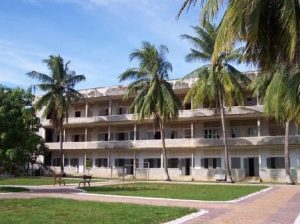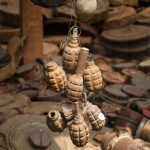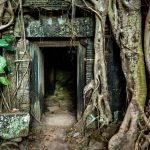 Freshly off a sweltering, barely-running bus, I’m poised at the entrance to Tuol Sleng Genocide Museum, or as it’s known to most visitors, S21. This was a former schoolhouse turned torture prison from 1975-79 during the Khmer Rouge’s notoriously brutal, merciless, yet hasty, reign of Cambodia.
Freshly off a sweltering, barely-running bus, I’m poised at the entrance to Tuol Sleng Genocide Museum, or as it’s known to most visitors, S21. This was a former schoolhouse turned torture prison from 1975-79 during the Khmer Rouge’s notoriously brutal, merciless, yet hasty, reign of Cambodia.
I hand over the small entrance fee, and am instantly clouted by the deceptively pleasant grounds. Aromas of freshly planted flowers punctuate the insane humidity. The recognizable deep green flora of South East Asia acted as a remarkable foreground to what looked like, essentially, a small block of East London council flats, transforming the building into something much more exotic than one might first expect.
But after a few minutes, the loaded, burdensome atmosphere does begin to weigh on your shoulders. It becomes clear that here is place where detestable, sickening events happened. And as one enters the few buildings, looking into and walking around the myriad rooms, the severity of what happened here is soon plainly manifest, as many areas of the prison have been left precisely as Ho Van Tay, a Vietnamese combat photographer, discovered them in 1979.
The most tormenting room I came across was one in which ‘valuable’ political prisoners were held and tortured. At first, the room appears to house just an iron bed, and some shackles, but look around for a few seconds more and one is greeted by the blood splattered stains on the walls, floor and ceiling. The chips in the walls where poorly-aimed instruments of torture had struck. One soon begins to comprehend the terror and trepidation that Cambodians were living in during this appalling, historic period, when the Khmer Rouge revolted against the then government in a bid to convert the country into an agrarian utopia.
For this utopia to succeed, it was believed, all religious and educated citizens must be annihilated. And so within days of Pol Pot overthrowing the government, the genocide began, leading to 20,000 (of which, only 7 survived) of the 1.6 million citizens who were killed being processed through S21.
The bulk of these citizens were kept in classrooms constructed for 25 students, each acting as living quarters for 60 prisoners, all of whom were shackled to one of two iron bars which furnished the room. All prisoners and were forbidden from speaking or moving. No bedding was provided.
And so it’s unimaginable not, after seeing these rooms, to saunter along the open corridors between the collected cells and torture rooms which overlook the lush grounds, without at least attempting to envisage and depict what it must have been like during that period. What were the sounds? The smells? The haunting questions that run through one’s mind leave one sombre and disturbed for quite some time, and this is only accentuated when you reach one of the final rooms of the prison.
This is where all the records, photos, and confessions of prisoners are put on display as an exhibition for the visitors. The foreboding angst and sorrow in the eyes of so many of the photographed citizens strikes a chord so deep, it’s hard to pick yourself up when you sooner or later recoil to your hostel. These are people who perceived that the likelihood of survival was minimal. This, they had probably accepted. But it was the distress of the unknown, impending interrogation that stares you back in the face. It’s an appalling exercise to attempt to place oneself in one of the prisoner’s shoes. To imagine how it must have felt at that point when you’re being photographed before being led away and shackled to the iron bars for the remaining few weeks of your life.
But one thing that does illuminate and expound more clearly what truly went on at S21 is the artwork of former prisoner Vann Nath, some of which is on display around the prison, bringing to life some of the torture techniques used during those years; tying people’s hands behind their backs, and lifting them by their wrists over what used to be the children’s swings until the shoulders were dislocated. This would be repeated until the prisoner finally confessed to whatever needed to be confessed to. Some of these paintings are harrowing in the extreme, and sincerely help one to appreciate the cultural significance of S21, especially while so many of the torturers and prison guards are still roaming Cambodia’s streets today.
This really is the ‘Auschwitz of Cambodia’. Of course, it’s not the archetypal attraction of most countries, but for a nation that has so recently been subject to genocide, this remains an episode that lives on in the Cambodian people today. The memories, wounds and trauma are still raw, and so to see where just some of these atrocities actually happened, and to witness the conditions under which they took place, is a massive eye-opener and solemn reminder of how brutal the modern world can be and absolutely shows the heart of so many.





Rob, thanks for writing this. My husband and I are currently in Cambodia working with a local NGO, and I find that learning about the genocide that occurred here helps to understand the people of Cambodia and their current struggles. We plan on visiting S21 in a few weeks, but to be honest I’m not totally sure I’ll be able to handle it.
Thanks Alison 🙂 It’s a fascinating place. I’d recomment going just to see the conditions there. It’s extremely humbling, but also keeps alive what happened so recently.